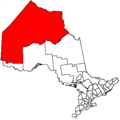This article needs additional citations for verification. Please help improve this article by adding citations to reliable sources. Unsourced material may be challenged and removed. Find sources: "Weenusk First Nation" – news · newspapers · books · scholar · JSTOR (November 2024) (Learn how and when to remove this message) |
Weenusk First Nation (Cree: ᐐᓈᐢᑯ ᐃᓂᓂᐗᐠ (wînâsko ininiwak); unpointed: ᐧᐃᓇᐢᑯ ᐃᓂᓂᐧᐊᐠ) is a Cree First Nation band government in the Canadian province of Ontario.[1][2] In September, 2007, its total registered population was 516. Weenusk First Nation was an independent member of the Nishnawbe Aski Nation (NAN) but now have joined the Mushkegowuk Council, a regional tribal council, who is also a member of NAN.
Weenusk First Nation's reserve is the 5310 ha Winisk Indian Reserve 90. Associated with the reserve is their Winisk Indian Settlement also known as Peawanuck, which also holds reserve status. Originally, the Weenusk First Nation was located within their reserve, but they were forced to move 30 km (19 mi) southwest to Peawanuck when on May 16, 1986, spring floods swept away much of the original settlement, which had been located 6 km (4 mi) upriver from Hudson Bay.
In the Cree language, "Peawanuck" means "a place where flint is found," while "Weenusk" means "ground hog." The community, being primarily Swampy Cree, speaks the n-dialect of the Cree language. Being that the community is composed of Cree, Oji-cree, Ojibwa and Métis peoples, in addition to Cree, Anishininiimowin and Ojibwemowin are also spoken there.
Governance
[edit]Weenusk is governed by Chief Joey Hunter and his three councillors: Jeff Hunter, Leah Hunter, and Paul Koostachin.
External links
[edit]- Chiefs of Ontario profile Archived 2010-10-17 at the Wayback Machine
- Detailed community profile from the Wakenagun Development Corporation
- AANDC profile
References
[edit]- ^ Long, John S. (2010-11-19). Treaty No. 9: Making the Agreement to Share the Land in Far Northern Ontario in 1905. McGill-Queen's Press - MQUP. ISBN 978-0-7735-8135-7.
- ^ Foster, Karen R.; Jarman, Jennifer (2022-03-03). The Right to Be Rural. University of Alberta. ISBN 978-1-77212-595-5.
55°01′13″N 85°42′28″W / 55.02028°N 85.70778°W / 55.02028; -85.70778
The Numbered Treaties: Treaty Nine | |
|---|---|
| Numbered Treaties | |
| Treaty Nine Nations |
|
| Cities | ||
|---|---|---|
| Towns | ||
| Townships | ||
| First Nations |
| |
| Indian reserves |
| |
| Indian settlements | ||
| Unorganized areas | ||
| Local services boards | ||
| Unincorporated communities | ||
This Northern Ontario geographical article is a stub. You can help Wikipedia by expanding it. |
- Pages using gadget WikiMiniAtlas
- Articles needing additional references from November 2024
- All articles needing additional references
- Use Canadian English from January 2023
- All Wikipedia articles written in Canadian English
- Articles containing Cree-language text
- Webarchive template wayback links
- Coordinates on Wikidata
- All stub articles


